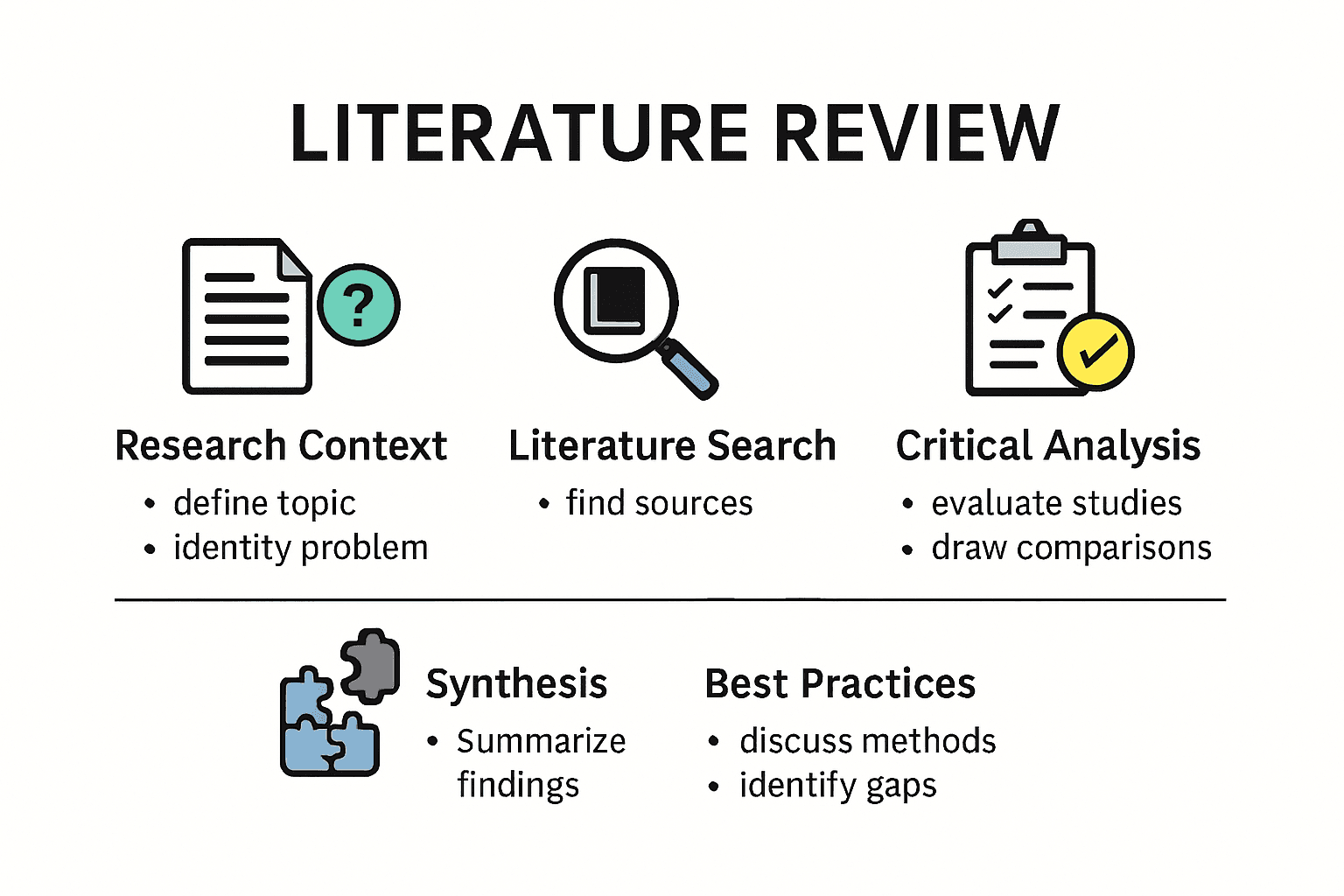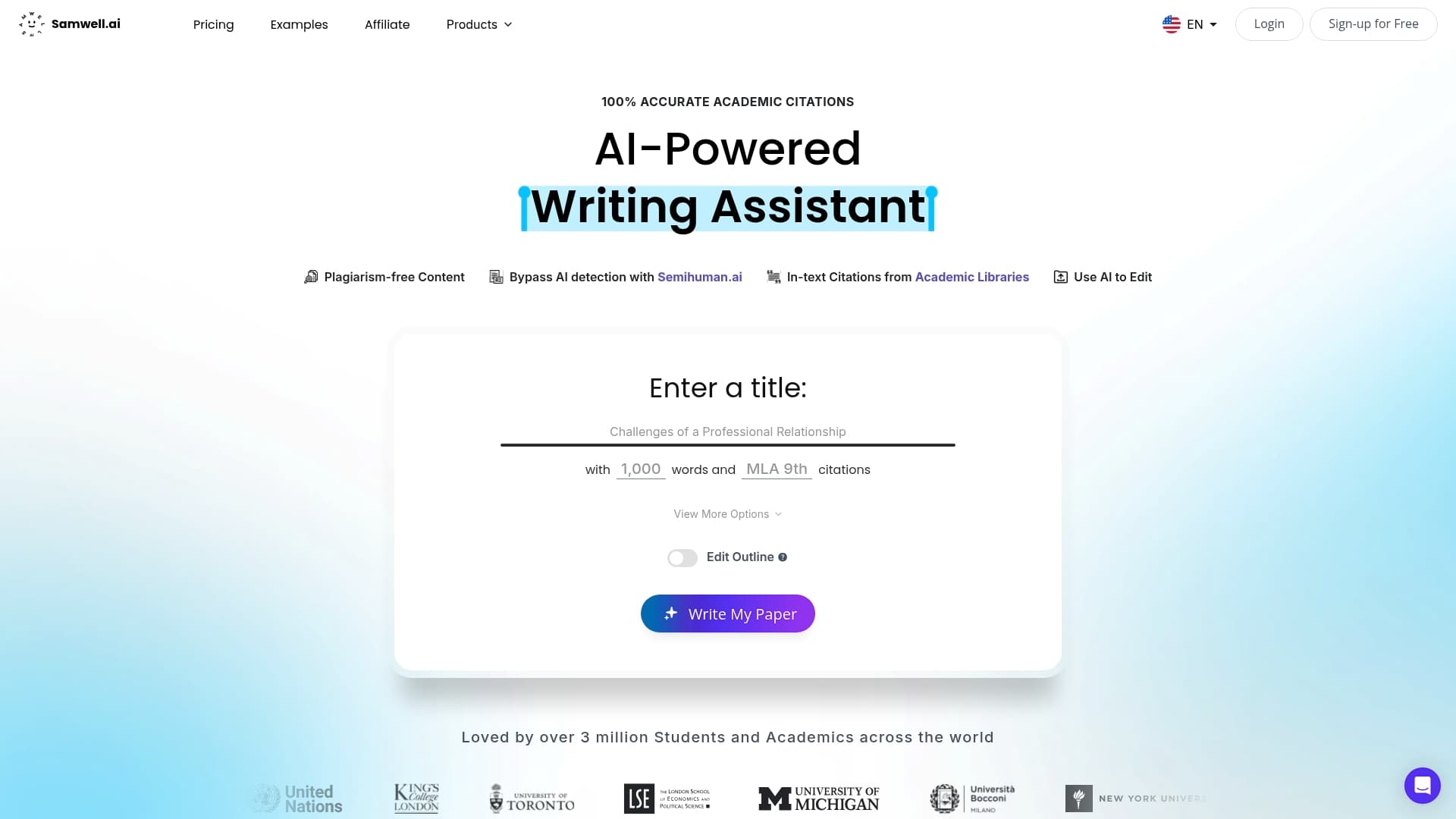Blog
Learning Materials
How to Write a Literature Review of a Project in 2025
Updated: July 13, 2025

Writing a literature review for a project can feel overwhelming, especially with so many resources and tools changing every year. Here is something most students do not realize. AI-powered tools now help researchers map, categorize, and summarize studies faster than ever, trimming days off the process. Still, using these modern platforms is not the secret to a good review. The real difference comes from how you question, select, and connect the research itself. Ready for a smarter, sharper approach?
Table of Contents
- Understanding The Purpose Of A Literature Review Dockerfile README.md email-templates i18n-config.ts i18nConfig.ts next-sitemap-samwell.config.js next-sitemap-semihuman.config.js next.config.js node_modules package-lock.json package.json process_content.js public scripts src svgr.d.ts translations tsconfig.json Establishing Research Context And Significance Dockerfile README.md email-templates i18n-config.ts i18nConfig.ts next-sitemap-samwell.config.js next-sitemap-semihuman.config.js next.config.js node_modules package-lock.json package.json process_content.js public scripts src svgr.d.ts translations tsconfig.json Critical Analysis And Theoretical Integration Dockerfile README.md email-templates i18n-config.ts i18nConfig.ts next-sitemap-samwell.config.js next-sitemap-semihuman.config.js next.config.js node_modules package-lock.json package.json process_content.js public scripts src svgr.d.ts translations tsconfig.json Strategic Research Positioning
- Key Steps To Create A Literature Review Of A Project Dockerfile README.md email-templates i18n-config.ts i18nConfig.ts next-sitemap-samwell.config.js next-sitemap-semihuman.config.js next.config.js node_modules package-lock.json package.json process_content.js public scripts src svgr.d.ts translations tsconfig.json Defining Research Scope And Objectives Dockerfile README.md email-templates i18n-config.ts i18nConfig.ts next-sitemap-samwell.config.js next-sitemap-semihuman.config.js next.config.js node_modules package-lock.json package.json process_content.js public scripts src svgr.d.ts translations tsconfig.json Comprehensive Literature Search And Source Evaluation Dockerfile README.md email-templates i18n-config.ts i18nConfig.ts next-sitemap-samwell.config.js next-sitemap-semihuman.config.js next.config.js node_modules package-lock.json package.json process_content.js public scripts src svgr.d.ts translations tsconfig.json Analytical Synthesis And Organizational Strategies
- Best Practices And Common Mistakes To Avoid Dockerfile README.md email-templates i18n-config.ts i18nConfig.ts next-sitemap-samwell.config.js next-sitemap-semihuman.config.js next.config.js node_modules package-lock.json package.json process_content.js public scripts src svgr.d.ts translations tsconfig.json Strategic Source Selection And Evaluation Dockerfile README.md email-templates i18n-config.ts i18nConfig.ts next-sitemap-samwell.config.js next-sitemap-semihuman.config.js next.config.js node_modules package-lock.json package.json process_content.js public scripts src svgr.d.ts translations tsconfig.json Analytical Synthesis And Narrative Construction Dockerfile README.md email-templates i18n-config.ts i18nConfig.ts next-sitemap-samwell.config.js next-sitemap-semihuman.config.js next.config.js node_modules package-lock.json package.json process_content.js public scripts src svgr.d.ts translations tsconfig.json Structural Integrity And Presentation
- Useful Tools And Resources For Effective Literature Reviews Dockerfile README.md email-templates i18n-config.ts i18nConfig.ts next-sitemap-samwell.config.js next-sitemap-semihuman.config.js next.config.js node_modules package-lock.json package.json process_content.js public scripts src svgr.d.ts translations tsconfig.json Digital Research Databases And Search Platforms Dockerfile README.md email-templates i18n-config.ts i18nConfig.ts next-sitemap-samwell.config.js next-sitemap-semihuman.config.js next.config.js node_modules package-lock.json package.json process_content.js public scripts src svgr.d.ts translations tsconfig.json Artificial Intelligence And Literature Review Tools Dockerfile README.md email-templates i18n-config.ts i18nConfig.ts next-sitemap-samwell.config.js next-sitemap-semihuman.config.js next.config.js node_modules package-lock.json package.json process_content.js public scripts src svgr.d.ts translations tsconfig.json Collaborative Research And Networking Platforms
Quick Summary
| Takeaway | Explanation |
|---|---|
| Establishing Research Context and Significance | A literature review demonstrates understanding of existing knowledge, identifies research gaps, and positions new research strategically within the academic landscape. |
| Comprehensive Literature Search and Source Evaluation | Employ multiple academic databases and advanced search techniques to ensure relevant, credible, and recent sources are utilized in the review. |
| Analytical Synthesis and Organizational Strategies | Organize research thematically, chronologically, or methodologically to reveal patterns and contradictions, transforming a literature review into an active dialogue rather than a mere summary. |
| Best Practices for Source Selection | Critically evaluate sources for relevance, credibility, currency, and methodological rigor, avoiding indiscriminate source inclusion. |
| Utilization of Digital Tools and Collaborative Platforms | Leverage AI and digital research platforms to enhance the efficiency and depth of literature reviews while promoting collaborative scholarly communication. |

Understanding the Purpose of a Literature Review
 A literature review represents a critical analysis of existing scholarly work within a specific research domain. Its primary function goes beyond simply summarizing previous studies—it involves critically evaluating, synthesizing, and contextualizing research to establish a comprehensive understanding of the current knowledge landscape.
A literature review represents a critical analysis of existing scholarly work within a specific research domain. Its primary function goes beyond simply summarizing previous studies—it involves critically evaluating, synthesizing, and contextualizing research to establish a comprehensive understanding of the current knowledge landscape.
Establishing Research Context and Significance
Researchers utilize literature reviews to demonstrate their deep understanding of a particular field's existing knowledge. Learn more about research methodology by understanding how these reviews create an intellectual framework. The review serves multiple strategic purposes: identifying research gaps, preventing unnecessary duplication of existing studies, and positioning new research within the broader academic conversation.
According to research from the University of Oxford, a well-constructed literature review accomplishes three fundamental objectives:
- Mapping Existing Knowledge: Comprehensively documenting current research trajectories and theoretical developments
- Identifying Research Gaps: Highlighting unexplored areas that represent opportunities for novel investigations
- Theoretical Foundation: Developing a robust conceptual framework that guides subsequent research design
Critical Analysis and Theoretical Integration
Beyond mere description, a literature review demands rigorous critical analysis. Researchers must evaluate existing studies not just for their findings, but for their methodological approaches, theoretical assumptions, and potential limitations. Academic research experts emphasize that this critical perspective transforms a literature review from a passive summary into an active intellectual dialogue.
The review process involves systematically examining how different studies relate to each other, identifying patterns, contradictions, and emerging themes. This analytical approach helps researchers construct a nuanced understanding of their field, revealing how individual studies contribute to broader scholarly conversations.
Strategic Research Positioning
A comprehensive literature review does more than summarize existing work—it strategically positions new research within the academic ecosystem. By demonstrating a thorough understanding of current scholarship, researchers can articulate the unique contribution of their study. According to research methodology guidelines, this positioning is crucial for:
- Justifying the relevance and originality of the proposed research
- Establishing theoretical and methodological foundations
- Providing context for research questions and hypothetical frameworks
Ultimately, a literature review is an intellectual journey that transforms fragmented research into a coherent narrative. It requires researchers to be both historians and critics of their academic domain, weaving individual studies into a comprehensive understanding of knowledge development.
Key Steps to Create a Literature Review of a Project
Creating a comprehensive literature review requires a systematic and strategic approach that transforms scattered research into a coherent scholarly narrative. The process demands careful planning, meticulous research, and analytical thinking to effectively synthesize existing knowledge within a specific academic domain.
Defining Research Scope and Objectives
The first critical step involves precisely defining the research boundaries and objectives. Explore advanced research methodology to understand how researchers establish their review's focus. According to research methodology experts at MIT, this initial phase requires researchers to:
- Formulate Clear Research Questions: Develop specific, focused inquiries that guide the literature review
- Determine Geographical and Temporal Boundaries: Establish time frames and geographical contexts relevant to the research
- Identify Specific Disciplines or Interdisciplinary Areas: Clarify the academic domains to be explored
Researchers must create a focused research framework that prevents scope creep and ensures a targeted, meaningful investigation. This involves narrowing down broad topics into manageable research questions that can be systematically explored through existing literature.
Comprehensive Literature Search and Source Evaluation
Conducting a thorough literature search demands sophisticated research strategies. Academic research guidelines recommend using multiple academic databases and implementing advanced search techniques. The search process involves:
- Utilizing academic databases like Web of Science, Scopus, and Google Scholar
- Applying advanced search techniques including Boolean operators and specific keyword combinations
- Evaluating source credibility through factors such as peer-review status, publication reputation, and author expertise
According to research from Stanford University, effective source selection requires a critical approach. Researchers should prioritize peer-reviewed journal articles, academic books, and scholarly publications while critically assessing each source's relevance, methodology, and potential biases.

Analytical Synthesis and Organizational Strategies
Transforming collected research into a coherent narrative requires sophisticated analytical skills. Research methodology experts suggest organizing literature through multiple potential strategies:
- Thematic organization
- Chronological progression
- Methodological comparison
- Theoretical framework alignment
Effective synthesis involves identifying patterns, contradictions, and gaps across different studies. Researchers must move beyond simple description, critically analyzing how individual studies contribute to broader academic understanding. This approach transforms a literature review from a passive summary into an active intellectual dialogue that reveals the evolving nature of academic knowledge.
Successful literature reviews are not mere collections of summaries but sophisticated intellectual constructions that provide insights into existing research, highlight knowledge gaps, and set the stage for future scholarly investigations.
Here is a table summarizing the key steps to create an effective literature review, along with their purposes and typical strategies:
| Step | Purpose | Typical Strategies/Actions |
|---|---|---|
| Defining Research Scope and Objectives | Set research boundaries; avoid scope creep | Formulate research questions; set time/area; clarify disciplines |
| Comprehensive Literature Search and Source Evaluation | Collect relevant, credible information | Use academic databases; advanced search; assess credibility/relevance |
| Analytical Synthesis and Organizational Strategies | Create a coherent, insightful scholarly narrative | Organize thematically/chronologically/methodologically; identify patterns/gaps |
Best Practices and Common Mistakes to Avoid
Crafting an exceptional literature review requires more than just collecting and summarizing research. It demands a sophisticated approach that balances critical analysis, scholarly rigor, and strategic presentation. Learn advanced academic writing techniques to elevate your research methodology.
Strategic Source Selection and Evaluation
Effective literature reviews hinge on meticulous source selection. According to research from Harvard University's Academic Writing Center, researchers must critically evaluate sources beyond surface-level credibility. Key considerations include:
- Relevance: Aligning sources directly with research objectives
- Credibility: Prioritizing peer-reviewed journals and reputable academic publications
- Currency: Focusing on recent research while acknowledging foundational studies
- Methodological Rigor: Assessing the scientific validity and research design of each source
Researchers frequently make the mistake of including sources indiscriminately. Academic research experts recommend a systematic approach that involves thoroughly examining each source's methodology, theoretical framework, and potential limitations.
Analytical Synthesis and Narrative Construction
Transforming individual research sources into a cohesive narrative represents the most challenging aspect of literature reviews. According to research methodology guidelines from Stanford University, successful reviews require:
- Identifying patterns and trends across multiple studies
- Highlighting contradictions and gaps in existing research
- Creating a critical dialogue between different scholarly perspectives
- Maintaining a neutral, objective analytical tone
Common pitfalls include over-reliance on description rather than critical analysis. Researchers must move beyond summarizing individual studies to construct a comprehensive understanding of the research landscape.
Structural Integrity and Presentation
The organizational structure of a literature review significantly impacts its effectiveness. Academic writing specialists recommend several organizational strategies:
- Thematic organization that groups studies by conceptual similarities
- Chronological progression demonstrating research evolution
- Methodological comparison highlighting different research approaches
- Theoretical framework alignment connecting studies through conceptual lenses
Researchers should avoid common mistakes such as:
- Inconsistent citation formatting
- Lack of clear transitions between sections
- Excessive quotation without critical interpretation
- Neglecting to discuss research limitations
An exceptional literature review is more than an academic exercise—it represents an intellectual journey that transforms fragmented research into a coherent narrative. By combining rigorous analysis, strategic organization, and critical thinking, researchers can create reviews that not only summarize existing knowledge but also illuminate pathways for future scholarly investigation.
Useful Tools and Resources for Effective Literature Reviews
The landscape of literature review research has dramatically transformed with the emergence of sophisticated digital tools and advanced technological resources. Explore advanced research methodologies to understand how modern researchers leverage cutting-edge technologies to streamline their academic investigations.
Digital Research Databases and Search Platforms
Modern researchers have access to powerful digital platforms that revolutionize literature search and retrieval. According to research from MIT Libraries, key digital resources include:
- Web of Science: Comprehensive citation database covering multiple academic disciplines
- Scopus: Extensive abstract and citation database with advanced search capabilities
- Google Scholar: Freely accessible platform for locating academic publications across diverse fields
- ResearchGate: Professional network enabling direct access to scholarly publications
Academic research experts recommend utilizing multiple platforms to ensure comprehensive source coverage. These databases not only provide access to scholarly articles but also offer advanced filtering mechanisms, citation tracking, and research trend analysis.
Artificial Intelligence and Literature Review Tools
Cutting-edge artificial intelligence technologies are transforming literature review processes. According to research from Stanford University's AI Laboratory, emerging AI-powered tools offer unprecedented capabilities:
- LitAI: Machine learning algorithms that automatically categorize and synthesize research publications
- Reference Management Software: Tools like Zotero and Mendeley for organizing and citing research sources
- Natural Language Processing (NLP) Tools: Advanced systems that extract key insights from complex academic texts
- Automated Literature Mapping: AI-driven platforms that visualize research connections and identify knowledge gaps
The AI Literature Review Suite represents a groundbreaking development, integrating functionalities such as searching, downloading, and organizing PDF files while generating succinct literature reviews using large language models.
Collaborative Research and Networking Platforms
Modern academic research extends beyond individual efforts, emphasizing collaborative knowledge creation. Research methodology experts highlight innovative platforms that facilitate scholarly exchange:
- ORCID: Global researcher identification system enabling transparent academic profiling
- Dimensions: Comprehensive research intelligence platform connecting publications, grants, and clinical trials
- Overleaf: Collaborative writing platform specifically designed for academic manuscripts
- Sci-Hub: Controversial but widely used platform providing access to paywalled academic publications
These platforms not only streamline research processes but also foster global academic collaboration, breaking traditional barriers of geographical and institutional limitations.
The convergence of artificial intelligence, advanced digital platforms, and collaborative technologies is reshaping how researchers conduct literature reviews. By strategically leveraging these tools, academics can dramatically enhance the efficiency, comprehensiveness, and analytical depth of their scholarly investigations.
Below is a comparison table summarizing leading digital and AI tools for literature reviews mentioned in the article, along with their main functions:
| Tool/Platform | Main Function | Type |
|---|---|---|
| Web of Science | Citation database for multiple disciplines | Research Database |
| Scopus | Abstract/citation database with advanced search | Research Database |
| Google Scholar | Free academic publication search | Research Database |
| ResearchGate | Network for accessing and sharing publications | Research Networking |
| LitAI | AI-powered categorization & synthesis of literature | AI Review Tool |
| Zotero, Mendeley | Organize and cite research sources | Reference Management |
| NLP Tools | Extract insights from academic texts | AI/Natural Language Proc. |
| AI Literature Review Suite | Search, download, organize, generate reviews | AI Review Suite |
| ORCID | Researcher identity and academic profiling | Networking/Collaboration |
| Overleaf | Collaborative academic writing | Collaboration Platform |
Frequently Asked Questions
How do I begin writing a literature review for my project?
To start a literature review, define your research scope and objectives clearly. This includes formulating specific research questions and determining the relevant time frame and geographical context for your topic.
What are the key steps involved in creating a literature review?
The key steps include defining your research scope, conducting a comprehensive literature search, evaluating sources for credibility, and synthesizing the information thematically or methodologically to create a coherent narrative.
How can I effectively evaluate sources for my literature review?
To evaluate sources, focus on their relevance to your research questions, check for peer-review status, assess the credibility of the publication, and ensure the research is recent and methodologically sound.
What tools can help me streamline the literature review process?
AI-powered tools like LitAI, reference management software like Zotero and Mendeley, and comprehensive databases such as Web of Science and Scopus can significantly enhance the efficiency of your literature review process.
Struggling with Your Literature Review? Let Samwell.ai Guide Your Success
Are you finding it hard to organize your sources, maintain originality, and meet strict citation guidelines while writing your literature review? The article highlighted just how stressful it can be to synthesize research, analyze findings, and avoid common mistakes like scope creep or weak source evaluation. These are real obstacles for students and academics alike, especially with the rapid adoption of AI tools and rising expectations for originality.

Samwell.ai was built to solve these challenges for writers like you
- Instantly generate structured literature reviews with tailored outlines using our Guided Essays feature
- Ensure your work is free from plagiarism risks with real-time originality checks powered by Semihuman.ai
- Easily follow MLA, APA, or your required citation style as you research and write
- Transform your process and finish your project with confidence
Visit Samwell.ai now to see how our advanced academic writing platform can help you elevate your literature review and stay ahead in 2025. Start your best project today
Recommended
Generate essays with Samwell.ai
Whether you’re a publisher, professor, journalist, or student, let us tailor a plan just for you.Most Read Articles

Your Guide to Help Writing a Essay Successfully
Expert tips for help writing a essay - from crafting a thesis to structuring your essay effectively.

How to Write Critical Thinking Essay: Expert Tips
Expert tips for writing a critical thinking essay. Learn how to structure, choose topics, and use evidence effectively.'

How to Write a Good Hook: A Step-by-Step Guide
Master the art of crafting a good hook with our guide. Create compelling openers for a memorable first impression.
